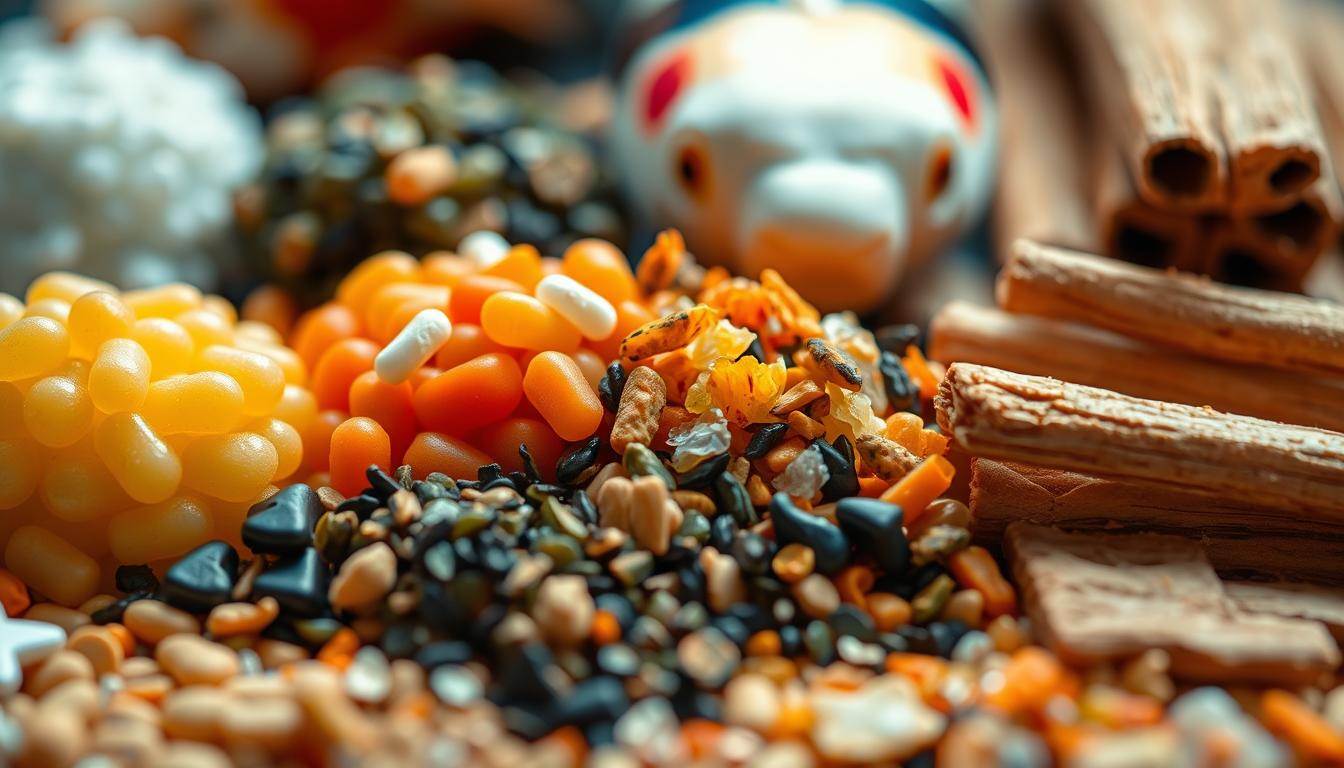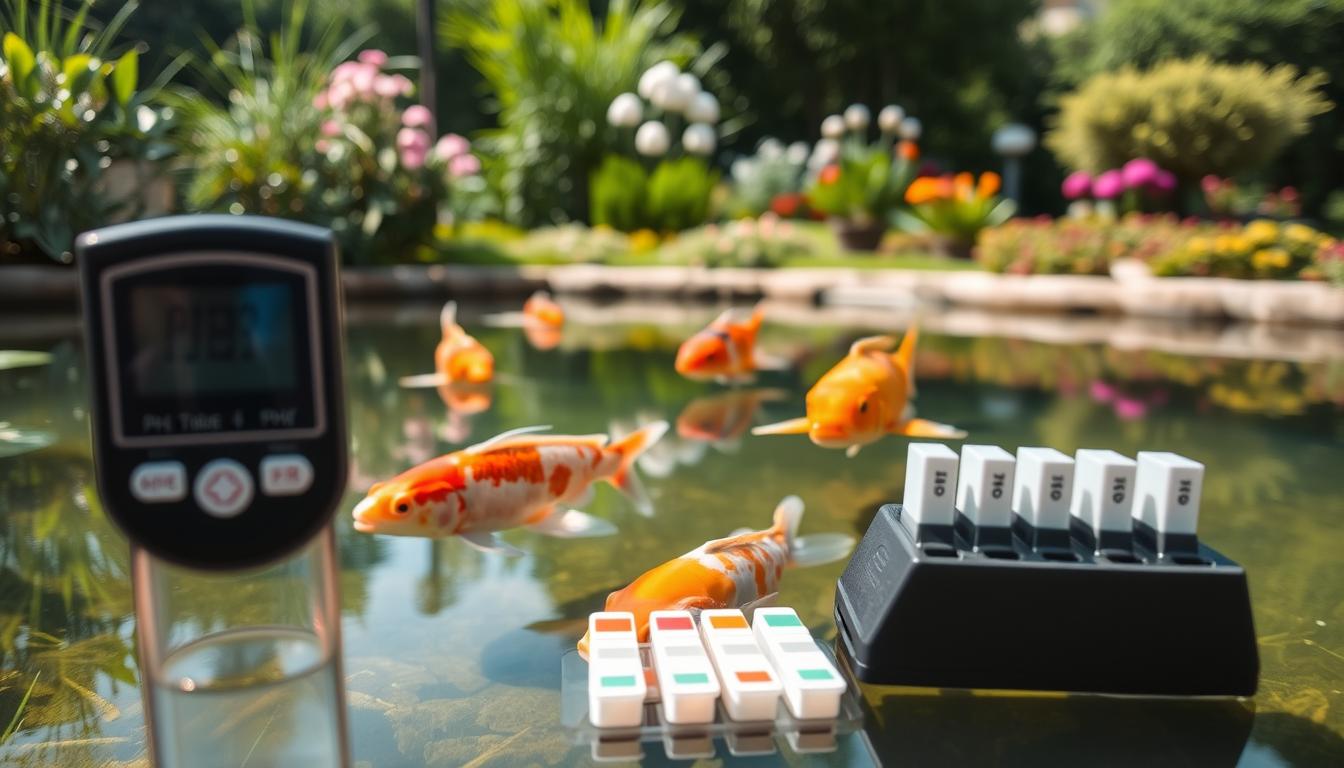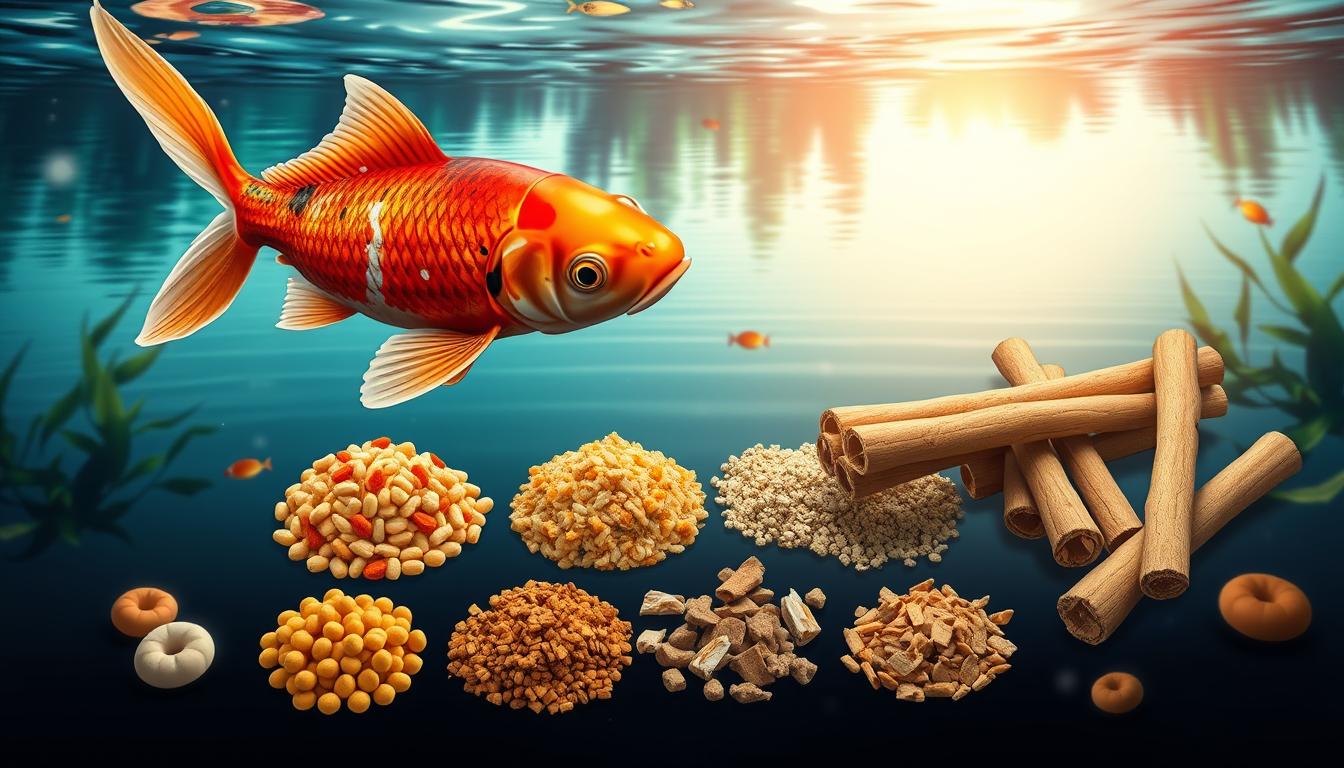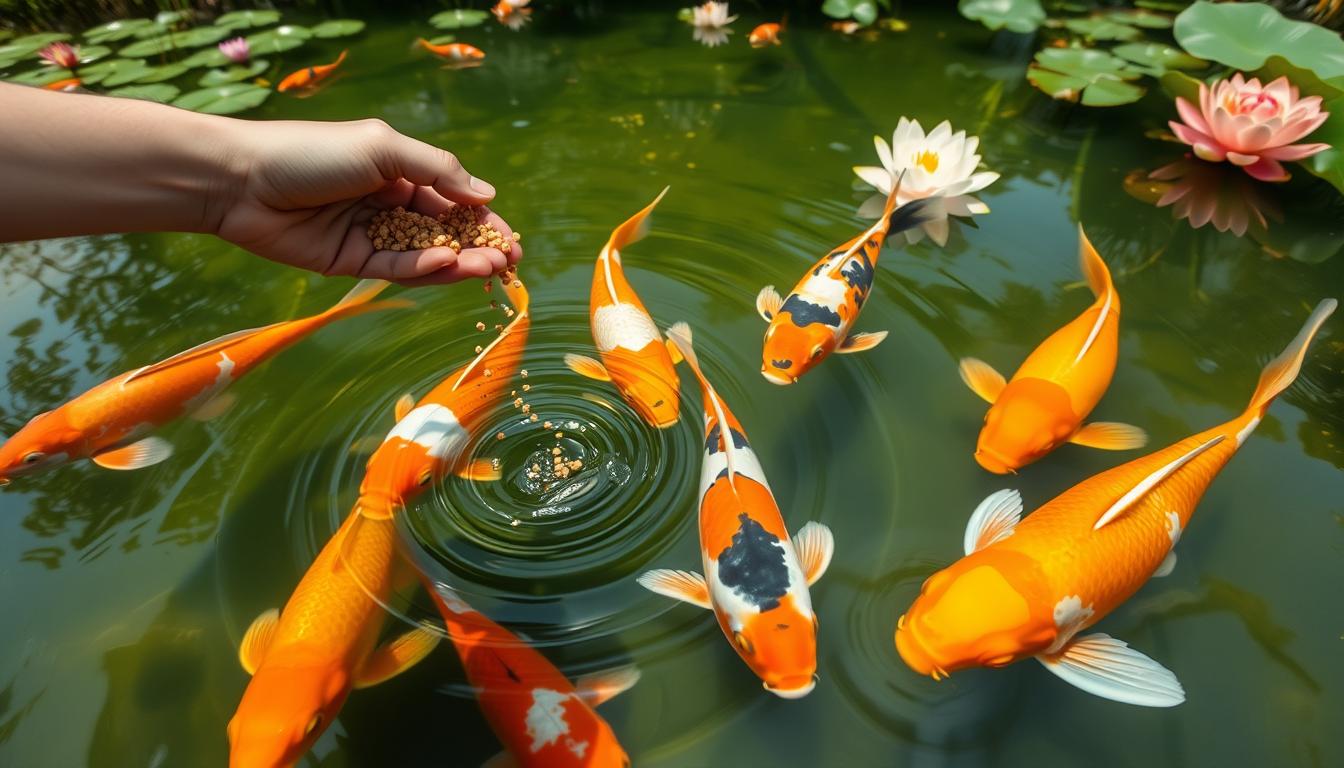Should You Choose Koi Fish Food Pellets, Flakes, or Sticks for Better Nutrition?
This post may contain affiliate links.
There’s something magical about watching vibrant, jewel-toned swimmers glide through a pond. Their colors shimmer like living art, and their graceful movements can turn any backyard into a sanctuary. If you’ve ever cared for these ornamental carp, you know their beauty isn’t just luck—it’s built on thoughtful nutrition. But with so many food options available, how do you decide what’s best?
For generations, brocaded carp—known as nishikigoi in Japan—have symbolized harmony and perseverance. Today, they’re cherished in water gardens across the United States, where owners strive to balance aesthetics with health. Choosing between pellets, flakes, or sticks isn’t just about convenience. It’s about understanding how each form impacts digestion, coloration, and longevity.
This guide cuts through the confusion. We’ll explore the pros and cons of each food type, backed by insights into their dietary needs. Whether you’re new to raising these elegant creatures or refining your care routine, the right choice can make all the difference.
Key Takeaways
- Proper nutrition directly affects the vibrancy and health of ornamental carp.
- Food form (pellets, flakes, or sticks) influences digestion and nutrient absorption.
- Brocaded carp have a rich cultural history and specific dietary requirements.
- Outdoor ponds in the U.S. often prioritize koi care for their visual and ecological benefits.
- This article compares food options to help both beginners and experts make informed choices.
Introduction to Koi Fish Nutrition
In the misty mountains of 19th-century Japan, rice farmers noticed something extraordinary. Their common carp began displaying unexpected patterns – living brushstrokes of crimson and snow white. This marked the birth of nishikigoi, the jeweled swimmers that would become a global symbol of elegance. Today, these ornamental fish require more than admiration; their legacy depends on precise dietary care.
Why Proper Nutrition Matters
For over 200 years, selective breeding has transformed these creatures into aquatic masterpieces. From fiery Kohaku to metallic Ogon varieties koi, each type reflects generations of craftsmanship. But vibrant scales and robust health don’t happen by chance. As one Japanese proverb states:
“A koi’s beauty flows from the caretaker’s hands to the pond’s depths.”
Three key factors make nutrition vital:
- Color enhancement: Specific nutrients intensify natural pigmentation
- Digestive efficiency: Food forms impact nutrient absorption rates
- Immune support: Balanced diets prevent common pond illnesses
Modern fish species enthusiasts face unique challenges. Unlike their wild carp ancestors, these ornamental swimmers can’t forage naturally in backyard ponds. Their dietary needs mirror the precision of their breeding – a delicate balance perfected through two centuries of practice. By understanding this heritage, owners can maintain both the physical splendor and cultural significance these living artworks represent.
Exploring Food Options: Pellets, Flakes, and Sticks
Just as a painter selects brushes, caretakers choose foods that shape aquatic masterpieces. Each form – pellets, flakes, or sticks – acts like a different tool, influencing health and visual appeal. Let’s examine how these options cater to unique needs.

Pellets: Precision Nutrition
Sinking or floating varieties offer flexibility for surface feeders and bottom grazers. High-density formulas pack proteins and color-enhancing astaxanthin, ideal for species like Kohaku or Showa. However, overfeeding can muddy water quality, requiring careful portion control.
Flakes: Color Amplifiers
Lightweight and quick to digest, flakes often contain spirulina and krill to intensify red and white patterns. They’re perfect for smaller ponds but dissolve rapidly, leaving residue if uneaten. Use them sparingly alongside other foods for balanced diets.
Sticks: Natural Grazing Mimicry
These slow-sinking options encourage natural foraging behaviors. Their sturdy texture suits larger ponds with mixed species, reducing competition during mealtimes. While less nutrient-dense than pellets, they’re excellent for supplemental feeding.
- Pro Tip: Rotate food types seasonally – flakes in summer for quick energy, pellets in spring for growth.
- Match food size to your pond dwellers’ mouths to prevent waste.
Assessing Nutritional Value for Your Koi Fish
Did you know the food you serve impacts water clarity for years? A thriving aquatic ecosystem depends on balancing nutrition with environmental care. What goes into your swimmers directly affects what stays in their home.

Ponds age like fine wine when maintained properly. Over time, uneaten food residues accumulate, altering pH levels and oxygen content. One study showed 68% of water quality issues trace back to dietary choices. As veteran keeper Linda Carter notes:
“Your feeding routine writes the pond’s future story – make each chapter count.”
Compare common food impacts:
| Food Type | Residue Level | Water Impact |
|---|---|---|
| Pellets | Low | Stable pH |
| Flakes | High | Rapid clouding |
| Sticks | Medium | Slow decomposition |
Test water monthly using kits from local garden centers. Look for foods with digestible proteins above 30% and ash content below 8%. Rotate between floating and sinking options to reduce waste buildup.
Remember: clear water reflects smart feeding. Your pond’s sparkle today ensures vibrant colors tomorrow.
The Role of Diet in Koi Fish Health and Lifespan
A century-old Japanese legend claims the oldest ornamental carp lived 226 years – a testament to meticulous care. While modern pond animals rarely reach such ages, their vitality directly reflects dietary choices. What we serve becomes the building blocks of their shimmer and strength.

Nutrition’s Impact on Growth and Coloration
Selective breeding created living rainbows, but only proper feeding maintains their brilliance. Studies show carotenoid-rich diets boost red and orange hues by 40% compared to basic meals. Protein sources like krill and spirulina don’t just enhance coloration – they fuel growth rates critical for competitive show specimens.
Three key nutrients shape these aquatic jewels:
- Astaxanthin: Intensifies red pigments (found in shrimp meal)
- Lecithin: Improves scale luster and size potential
- Vitamin C: Strengthens immune systems in crowded ponds
Long-Term Health Benefits
Consistent care through balanced meals pays dividends over decades. Veteran breeder Hiroshi Yamamoto observes:
“The difference between a 10-year and 30-year lifespan? It’s written in their feeding schedule.”
High-quality diets reduce stress-related illnesses while supporting reproductive health in mature animals.
Compare traditional and modern food types:
| Diet Type | Key Benefit | Ideal For |
|---|---|---|
| Wheat-based | Digestive ease | Young swimmers |
| Algae-enhanced | Color depth | Show varieties |
| Probiotic mixes | Gut health | Senior pond dwellers |
Rotate between pellet sizes and floating/sinking options to match seasonal needs. Spring meals should prioritize growth, while autumn feeds might focus on immune support. Remember: vibrant coloration today stems from yesterday’s dietary care.
How to Choose the Best Food for Your Koi
Creating a thriving aquatic ecosystem starts with understanding the harmony between tradition and modern science. Japanese breeders from organizations like Zen Nippon Airinkai have refined feeding practices over 100–200 years, blending art with biology. Their approach teaches us that every meal shapes both health and heritage.

Feeding Frequency and Portion Control
Timing matters as much as ingredients. Feed ornamental swimmers 2–4 times daily during warm months, adjusting portions they can finish in 5 minutes. Cold weather slows digestion—reduce meals to once weekly when water drops below 50°F. Observe their behavior: eager surfacing signals hunger, while ignored foods suggest overfeeding.
Selecting Quality Ingredients
Zen Nippon Airinkai standards emphasize natural components mirroring ancestral diets. Look for these in premium foods:
- Shrimp meal for astaxanthin (boosts red hues)
- Spirulina algae for immune support
- Digestible wheat germ for young new varieties koi
Modern breeding techniques developed over 100–200 years demand precise nutrition. As one Zen Nippon Airinkai master notes:
“The best meals honor their lineage while nurturing tomorrow’s colors.”
Transition diets gradually—mix 25% new food with current meals, increasing weekly. Track scale brightness and activity levels to gauge success. High-quality choices today build decades of underwater splendor.
Historical Insights on Koi Varieties and Nutrition
Long before vibrant patterns dazzled ponds, humble river dwellers shaped aquatic history. The story begins with wild common carp (Cyprinus carpio) in Eurasian waterways – silvery survivors that fed civilizations for millennia. When these hardy swimmers reached Japanese rivers, farmers noticed something extraordinary: occasional bursts of color in their food stocks.
From Ancient Sustenance to Living Art
Selective breeding transformed practical protein sources into floating masterpieces. By the 1820s, Niigata prefecture villagers began isolating Amur carp (Cyprinus rubrofuscus) with reddish scales. As one chronicler noted:
“What began as dinner became poetry in motion.”
Three key developments changed everything:
- Genetic lottery: Spontaneous color mutations in common carp populations
- Cultural value: Samurai families prized rare specimens as status symbols
- Scientific classification: Distinguishing Cyprinus species enabled targeted breeding
Modern varieties owe their existence to these 19th-century breakthroughs. Breeders discovered that Amur carp carried genes for metallic sheens and deeper pigmentation. By crossbreeding regional strains, they created the foundation for today’s ornamental lineages.
Early diets mirrored natural foraging – algae, insects, and rice bran. Contemporary feeds now incorporate these ancestral elements through spirulina and wheat germ. Understanding this journey helps caretakers honor both biological needs and cultural legacy.
Optimizing Your Outdoor Pond Setup for Koi
A well-designed water garden mirrors nature’s balance—where every ripple supports life. For ornamental varieties bred over centuries, their environment acts as both canvas and caretaker. Let’s explore how to craft spaces where beauty and biology thrive together.
Pond Environment and Water Quality
Start with size: allow 250–300 gallons per fish to prevent overcrowding. Deeper areas (4–6 feet) help temperature-sensitive varieties like Gin Rin withstand summer heat. Incorporate these elements:
- Multi-stage filtration systems to handle waste
- Aeration pumps for oxygen-rich water circulation
- Shallow shelves planted with water lilies for shade
Zen Nippon principles emphasize simplicity. Traditional designs use natural stones and flowing water to reduce stress—a practice still favored in modern setups.
Seasonal Temperature Management
As temperatures shift, so do pond needs. Summer demands frequent partial water changes (10–15% weekly) to combat algae. In winter, floating de-icers keep surface areas open for gas exchange. Consider these adjustments:
| Season | Water Temp | Action |
|---|---|---|
| Spring | 50–68°F | Gradually increase feeding |
| Winter | Below 50°F | Switch to wheat-germ foods |
Monitor pH (7.0–8.5 ideal) and ammonia levels monthly. Pair practical maintenance with aesthetic touches—floating plants or submerged LED lights—to create sanctuaries where koi varieties flourish.
Managing Diet Transitions and Feeding Techniques
Like tending a delicate bonsai, adjusting ornamental swimmers’ diets requires patience and observation. Traditional rice paddies taught early breeders the value of gradual changes – a practice refined over 100–200 years and now embraced by modern water gardens. Sudden food swaps can shock digestive systems, but thoughtful transitions maintain vibrant health.
Gradual Transition Strategies
The Nippon Airinkai recommends blending 25% new food with current meals for 4–7 days. Increase by 25% every 3 days until fully transitioned. This mirrors ancestral methods where rice paddy carp adapted to seasonal food sources. Key steps:
- Mix pellet sizes if switching forms (flakes to sticks)
- Feed during calm morning hours to reduce competition
- Soak dry foods briefly to mimic natural texture
Observing Behavior During Dietary Switch
Watch for these success signs:
| Behavior | Positive Indicator | Concern |
|---|---|---|
| Surface Activity | Eager feeding within 2 minutes | Ignored meals |
| Waste Check | Firm, dark waste | Pale/stringy waste |
| Color Stability | Consistent scale brightness | Dull patches |
As one Nippon Airinkai master advises:
“Their movements speak their comfort – listen with your eyes.”
Modernwater gardensbenefit from these time-tested techniques, ensuring smooth transitions that honor centuries of aquatic stewardship.
Expert Tips on Supplementing Koi Diets
Imagine your pond as a living canvas – every brushstroke of color and energy depends on thoughtful nourishment. While primary foods form the foundation, strategic supplements can elevate health without overwhelming delicate systems. Let’s explore how to enhance meals for lasting vitality.
Recommended Supplements and Treats
Among japanese koi enthusiasts, spirulina tops the list for boosting blue and white hues. This algae powder mixes easily with pellets or sticks. For red enhancement, astaxanthin-rich treats like freeze-dried shrimp work wonders. Brands like Hikari and Tetra offer specialized formulas trusted in kept ornamental communities.
Consider these popular additives:
- Probiotic gels: Support digestion during seasonal changes
- Vitamin C drops: Strengthen immunity in crowded fish ponds
- Garlic extract: Natural parasite deterrent for outdoor setups
Adjust quantities based on your pond’s size and population. A 1,000-gallon water feature might need half a teaspoon of powdered supplements daily, while smaller setups require quarter doses. As breeder Mariko Tanaka advises:
“Treat supplements like spices – a pinch enhances, but a handful ruins the dish.”
Balance is key. Rotate between natural snacks like watermelon slices and commercial boosters. Look for products listing specific carotenoid percentages – aim for 100mg/kg astaxanthin in color-enhancing mixes. For japanese koi in heated winter ponds, wheat germ additives maintain energy without taxing digestion.
| Supplement | Frequency | Benefit |
|---|---|---|
| Spirulina | 3x weekly | Color depth |
| Probiotics | Daily (spring/fall) | Gut health |
| Krill meal | 2x weekly | Scale shine |
Among koi kept in ornamental settings, gradual introduction prevents stress. Start with weekly additions, monitoring activity levels and waste consistency. Premium diets paired with targeted supplements create thriving ecosystems where beauty and biology flourish together.
Enhancing Koi Fish Coloration and Vitality
The secret to dazzling pond displays lies in both science and art. Modern caretakers blend ancestral wisdom with cutting-edge nutrition to unlock nature’s full palette. Through selective breeding, today’s varieties showcase colors once deemed impossible – but maintaining their brilliance demands strategic care.
Dietary Additives for Vibrant Colors
Premium feeds now include ingredients that help improve natural pigmentation. Spirulina algae intensifies blues and whites, while astaxanthin from shrimp meal deepens red tones. For metallic varieties, try adding wheat germ oil to enhance scale reflectivity.
Top supplements used by champion breeders:
- Marigold extract for golden highlights
- Probiotic blends to boost nutrient absorption
- Vitamin C tablets dissolved in pond water
Maintenance for Lifelong Health
Daily routines help improve resilience against stressors. Remove uneaten food within 15 minutes and test water weekly for ammonia spikes. Seasonal shifts require adjustments:
- Spring: Increase protein for post-hibernation recovery
- Summer: Add shade plants to prevent color-fading UV exposure
- Winter: Switch to low-protein wheat-based formulas
The California Koi Club reported 30% brighter hues in specimens receiving monthly garlic-soaked pellet treatments. As member Lisa Nguyen shares:
“Consistency beats intensity – small daily efforts compound into jaw-dropping results.”
Annual vet checks catch early signs of nutritional deficiencies. Pair these with selective breeding-inspired diets to support new varieties developed for enhanced vitality. Remember: vibrant ponds thrive on balance – both in nutrition and care routines.
Conclusion
Every choice in aquatic care writes its own story – especially when balancing ancestral wisdom with modern science. The form of nourishment you select shapes more than digestion; it influences color vibrancy, waste management, and even pond chemistry. Pellets deliver precision nutrition, flakes amplify hues temporarily, while sticks encourage natural foraging behaviors.
Three elements determine success: the number of daily feedings, seasonal adjustments, and water quality harmony. Historical practices from Japan’s 200-year breeding legacy teach us that consistency matters most. Modern innovations like probiotic blends and color-enhancing supplements build upon this foundation.
Your pond thrives when you match food form to specific needs – floating pellets for surface feeders, slow-sinking options for shy grazers. Remember, the ideal number of meals changes with temperature and life stage. Pair this knowledge with gradual dietary transitions and proper filtration.
Ready to refine your approach? Join local aquatic clubs or online forums to exchange insights. Whether maintaining a backyard oasis or show-quality specimens, blending tradition with innovation ensures your swimmers flourish. Their radiant beauty will mirror the care behind every thoughtful choice.
